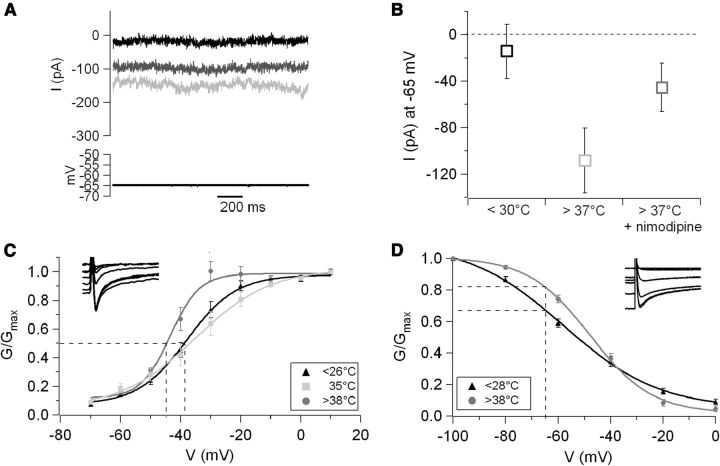Figure 7.
High temperature affects both activation and inactivation of native neuronal L-type current. A, Current recordings obtained at −65 mV at 28.5°C (black trace), 39°C (light gray), and 39°C in the presence of 10 μm nimodipine (focally applied, dark gray). The traces represent the CdCl2-sensitive components obtained by offline digital subtraction. B, Average CdCl2-sensitive current recorded at −65 mV in control temperature (27 ± 0.2°C) and at >37°C in control conditions and in the presence of nimodipine (3–10 μm, n = 8). C, Temperature increase induced a leftward shift in the current–voltage curve. The temperature dependence of this effect was most pronounced around the normothermia–hyperthermia boundary. Fitting Boltzmann curves to the data points yielded the following midpoints (indicated by the dotted lines) and slopes: at ≤26°C, V1/2 = −37.9 ± 0.9 mV, k = 8.2 ± 0.8 mV (n = 6); at 35°C, V1/2 = −34 ± 3.5 mV, k = 10.3 ± 1.2 mV (n = 4); and at ≥38°C, V1/2 = −43.5 ± 1.1 mV, k = 5.46 ± 1.3 mV (n = 5). Thus, an ∼9°C increase did not produce any significant shift in half-point or slope, whereas an additional 3°C increase caused a 9.5 mV shift in half-point and an ∼40% change in slope. D, Temperature also affected the inactivation curve. At <28°C, V1/2 was −57.9 ± 1.8 mV, and the slope was 18.3 ± 2.0 mV (n = 6). At temperatures >38°C, V1/2 was −47.8 ± 1.0 mV, and the slope was 11.8 ± 1.0 mV (n = 7). These differences resulted in a large change in channel availability at membrane potential around resting: at −66 mV, the availability increased from 68% at low temperature to 83% at >38°C, as evidenced by the dotted lines.

